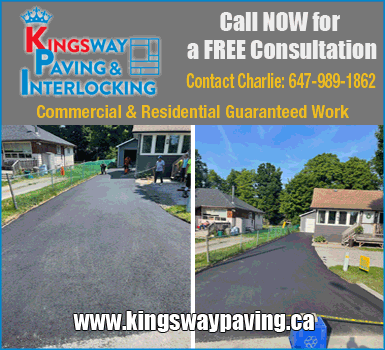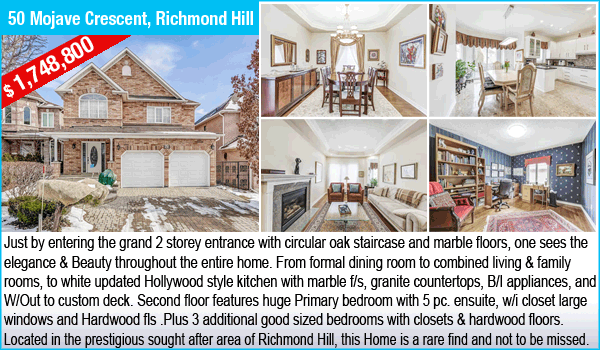Young families moving out of Toronto as a result of housing crisis
When Hannah Siklos and her husband, Sam, started thinking about buying a home, they wondered how long they could make life in Toronto work. If all they could afford was a condo, it did little more than buy time — maybe five years or so, until they might want to have kids and would want more space.
But nowadays, Siklos is certain of her future in the city she grew up in — making plans that stretch on 10, even 20 years. What changed? A 1910s row house — a more affordable foothold into Toronto’s single-family home market, offering more space than a condo for less cost than a detached house.
“Frankly, we were very surprised, overjoyed,” said Siklos, who closed on the Weston-Pelham Park row house in the $800,000-range last fall. “It really shifted our thinking.”
In today’s Toronto, as many young families have fled the city or even the province in search of more traditional and spacious single-family homes, many housing observers have called for a bolstering of what’s known as the “missing middle,” or housing that falls between a tower unit and a detached house.
But as the city has opened the door for new and expanded housing types from backyard suites to multiplexes, and encouraged more “family-sized” apartments, the question remains: what kind of home could keep young families from fleeing for the suburbs, and can Toronto deliver?
Siklos and her husband found their answer near St. Clair Avenue West and Old Weston Road. Where about half of the homes in their area are detached or semi-detached, just over 15 per cent are row houses like Siklos’ that can offer backyards and extra space with slightly lower price tags. There are some duplexes, plus a third of the housing stock made up of walk-up apartments of four storeys or less.
While Toronto’s child population has dropped in the last decade, in this small pocket it’s been rising. As of the last census, nearly 20 per cent of residents were age 14 or younger versus 13.8 per cent citywide; 5.5 per cent were age four or under, also higher than the citywide rate.
James Frodyma, a Toronto realtor who often works with young first-time homebuyers, says he sees many searching for mid-sized options like townhomes. They simply can’t afford Toronto’s detached houses — now averaging nearly $1.7 million — but still want space to grow their family.
The problem is that not enough exists, he said.
For some buyers, Frodyma says larger condos and apartments are an attractive option, given indoor parking and elevators rather than stairs for carrying in groceries or strollers. Others gravitate toward lowrise living, feeling a townhome is more “homey” and tends to offer more space. But in both cases, “there’s a limited supply,” he said.
“We want to keep young people here. That’s the future of the city,” Frodyma said.
On a recent March break morning, the signs of a kid-dominated community were evident in Weston-Pelham Park. Bright plastic slides dotted backyards of neatly arranged townhomes, with bikes and car seats on the porches of semis and row homes, and a pair of young boys chatting in the local park.
“You sit in that park long enough, you meet everyone,” said Agata Gidzinski, who has rented a house nearby since the summer. She and her partner previously rented a one-bedroom in Roncesvalles, and after welcoming their first child nearly two years ago, realized they needed something bigger — but they were priced out of two-bedrooms in their area.
Weston-Pelham Park offered them a chance to stay in the city while finding the kind of home their growing family needed, Gidzinski said. The couple now pays $2,500 plus utilities for a single-family home.
The young families who spoke with the Star were looking for much more than brick-and-mortar when considering where to live, pointing to other factors like transit access and playgrounds, as well as more intangible features.
“The mom group I have, the parent group I have, we’ve just made this really beautiful community,” Gidzinski said, noting many parents of young kids in the area would co-ordinate park meetups via WhatsApp.
For Siklos and her husband, access to cycling routes and public transit were important factors in choosing a home, and they were happy to find somewhere they could easily head outside with their West Highland terrier, Tony. She believes a hankering for space and greenery — versus life “up in a tower” — was amplified for many city dwellers by the COVID-19 pandemic.
The other major factor for them was staying as close as possible to their family and friends. “When we think about the possibility of having kids, with that social fabric, leaving Toronto would be an enormous loss. We would lose any sense of child care support, or social network, or peers going through the same thing. Maintaining all of that was extremely important to us.”
She’s come to love the energy of her new neighbourhood, which seems to surge with the schedule of the school day — a buzz before the first bell and after classes let out. “It feels like the whole neighbourhood lives and breathes the routines of a child.”
Dave Wilkes, president of the Building Industry and Land Development Association, says he’s watched over the years as securing family-sized housing has required young buyers to look further and further from Toronto.
Faced with higher land values and costs, he said some Toronto builders may be attracted to building condos rather than lowrise developments like townhomes to spread the costs across more units, he said.
“The land in the City of Toronto is going to be more expensive than something like or Oshawa,” Wilkes said.
It was also a question of demand, he said, with so many young buyers looking for cheaper entry-level condos. While there may be some demand for larger apartments, he said once you reached two or three bedrooms, the price points tended to be comparable with lower-rise options like townhomes.
Wilkes sees Toronto as making progress toward bolstering its mid-sized home stock in recent years, pointing to decisions like the recent changes to zoning laws that opened up areas previously roped off for detached and semi-detached homes to allow multiple units. But if officials want to see development of more townhomes, he suggested incentivizing builders by extending as-of-right permissions as well as reconsidering requirements such as angular planes — a kind of sloped design — to maximize a home’s “livable area.”
This article was first reported by The Star












